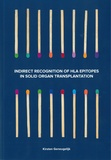Indirect recognition of HLA epitopes in solid organ transplantation

Geneugelijk, Kirsten
- Promoter:
- prof.dr. C.E. (Erik) Hack
- Co-promoter:
- dr. E. (Eric) Spierings
- Research group:
- Spierings
- Date:
- June 27, 2017
- Time:
- 12:45 h
Summary
Alloreactivity due to HLA mismatches between donor and recipient remains the major limiting factor in successful graft outcome after solid organ transplantation. Minimizing the number of HLA mismatches between donor and recipient is a classical and a powerful method to avoid B cell- and T cell-mediated alloreactivity after transplantation. Although the number of HLA mismatches is a potent indicator of post-transplantation complications, recent studies suggest that this method may be further refined by assessing the immunogenicity of individual HLA mismatches, as the immunogenicity of individual HLA mismatches is highly variable. Over the last decades, identified HLA alleles have been extensively characterized with regard to their three-dimensional structure and their exact amino acid sequence. This extensive characterization allowed the identification of functional epitopes on HLA that are involved in the alloimmune response after transplantation. Using this knowledge on clinically relevant epitopes and their location on HLA, rather than counting the number of HLA mismatches between donor and recipient, allows a more sophisticated matching method for solid organ transplantation. The concept in which epitopes are used for recipient-donor matching, rather than the number of HLA mismatches, is designated as epitope-based HLA matching.
In this thesis we describe PIRCHE-II (Predicted Indirectly ReCognizable HLA epitopes) as a method for epitope-based HLA matching in solid organ transplantation. The PIRCHE-II algorithm predicts indirect T cell recognition by predicting mismatched HLA-derived epitopes that can be presented on HLA class II molecules of the recipient.
In the first part of the thesis we further improved the PIRCHE infrastructure to facilitate the clinical application of the PIRCHE-II algorithm. The PIRCHE algorithm requires sufficient information to be able to calculate PIRCHE numbers. Therefore, the complete amino acid sequence has to be available to exactly identify the amino acid polymorphisms between donor and recipient. The complete amino acid sequence is required at two levels: [1] the complete amino acid sequence of all identified HLA alleles need be available for setting-up the PIRCHE database, and [2] high- or allelic-resolution HLA typing of both donor and recipient need to be available as input for the PIRCHE algorithm, as serological typing does not provide detailed information on the exact allelic variation between HLA alleles. Since the HLA database often contains incomplete amino acid sequences and HLA typing data in solid organ transplantation settings are often restricted to serological/low-resolution level, we used different approaches to identify the amino acid polymorphisms between HLA alleles. To solve the first problem, we used an automated nearest-neighbor-based approach to extrapolate incomplete HLA sequences that were present in the IMGT/HLA database to obtain the complete amino acid sequence of these incomplete HLA sequences. To solve the second problem, we developed a computational approach to calculate PIRCHE-II values using serological split level HLA typing as input for the algorithm. The approaches to solve the two problems are described and validated in this thesis.
Since PIRCHE-II is theoretically associated with indirect CD4+ T cell alloreactivity, PIRCHE-II may play a role in HLA antibody formation in HLA sensitizing settings. In the second part of the thesis we describe how we might apply the PIRCHE-II algorithm in different HLA sensitization settings. Previously, the impact of PIRCHE-II on de novo HLA antibody formation was shown in a small cohort consisting of 21 kidney transplant recipients. In this thesis we confirmed this observation in a different setting; after successful pregnancies, the number of PIRCHE-II presented by maternal HLA-DRB1 was related to the formation of HLA antibodies directed towards fetal HLA class I. In contrast to successful pregnancies that were not preceded previous miscarriages, the number of PIRCHE-II was not related to HLA antibody formation in women with a successful pregnancy that was preceded by previous miscarriages. We also showed that PIRCHE-II was involved in the formation of HLA class II specific antibodies after pancreas and pancreatic islet transplantation. Since a major part of the patients with donor-specific HLA antibody formation will develop antibody-mediated rejection within the first year after transplantation, we also investigated the role of PIRCHE-II in graft failure after kidney transplantation. We showed that the number of PIRCHE-II was related with graft failure after kidney transplantation, indicating that PIRCHE-II may be a useful tool to identify permissible HLA mismatches in solid organ transplantation.
The findings in this thesis suggest the PIRCHE-II algorithm may provide the opportunity to identify permissible HLA mismatches in solid organ transplantation, thereby minimalizing HLA sensitization and prolonging graft survival.